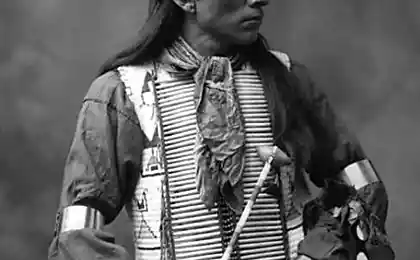1638
Brazilian Indians
While in Brazil the Indians represent less than one percent of its nearly 200 million inhabitants, the country (along with Venezuela) is the main and the last refuge for tribes who continue their traditional way of life in the tropical rain forests, known as jungle. However, the onset of civilization every year becomes more tangible. The Indians are not going to give up, and, increasingly, half-naked men with bows and arrows can be seen on the streets of the Brazilian metropolis during various protests.
Native American tribe Arar watching competitions in archery at the festival of indigenous peoples of Brazil in the city of Altamira, state of Pará. August 15, 2005
Photo: Paulo Whitaker / Reuters
Arara live in the east in the Brazilian Amazon state of Para, between the Xingu and iriri river. They came into contact with white people in the middle of the XIX century, and now the number of the tribe does not exceed 500 people.
25 pictures via lentaru

The boy from the tribe Arar fishing in the river Xingu. Altamira, State of Para, Brazil. April 28, 2010
Photo: Ricardo Moraes / Reuters
In the municipality of Altamira, home to Arar, under construction hydroelectric Belo Monte, which will be the third largest in the world. The dam on the river Xingu would flood large areas of jungle, which causes the active protests by the Indians, who will lose their traditional habitat.
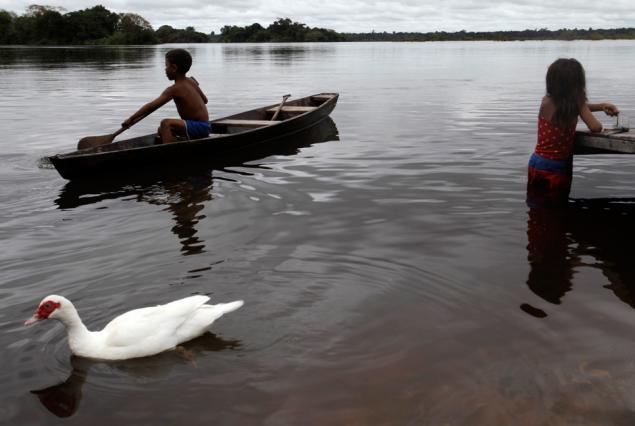
Kayapo Indian and macaw in the village Kikretum, State of Pará, Brazil.
Photo: Ricardo Moraes / Reuters
Kayapo tribe lives in the Xingu river basin in the states of Para and Mato Grosso and has nearly eight and a half thousand people. Kayapo leaders are activists of international environmental actions for the protection of the Amazon rain forest. In particular, they collaborated with popular singer Sting, in addition to well-known variety of achievements and environmental initiatives.
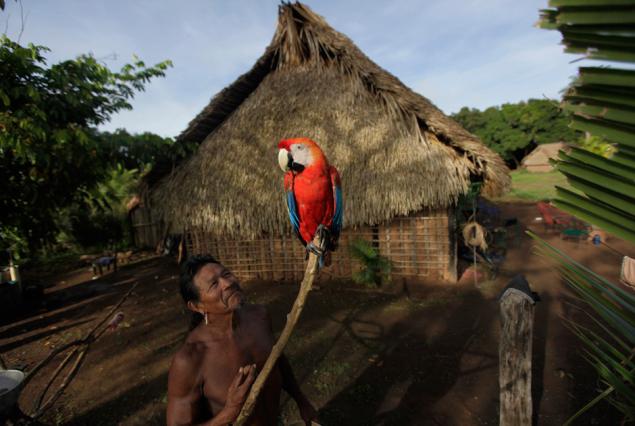
Kayapo boy in traditional livery. San Feliz, State of Pará, Brazil.
Photo: Ricardo Moraes / Reuters
Although the Kayapo had long been in contact with white people, but some clans living in a remote jungle, escape the influence of civilization. For example, in 2007, it was opened metyuktire tribe, whose members go completely naked. Men clothes only for the protection of the penis, while women shave their heads.

The village of Yanomami Indians in the Venezuelan state of Amazonas.
Photo: Carlos Garcia Rawlins / Reuters
Since 1960, when the Yanomami came into contact with Western civilization, do not stop their conflicts with garimpeyru gold diggers, who is at your own risk involved in the extraction of precious metals in the remote areas of the Amazon jungle. The summer of 2012 the Indians claimed that they were attacked by the Brazilian garimpeyru shelled their village by helicopter and killed 80 members of the tribe.
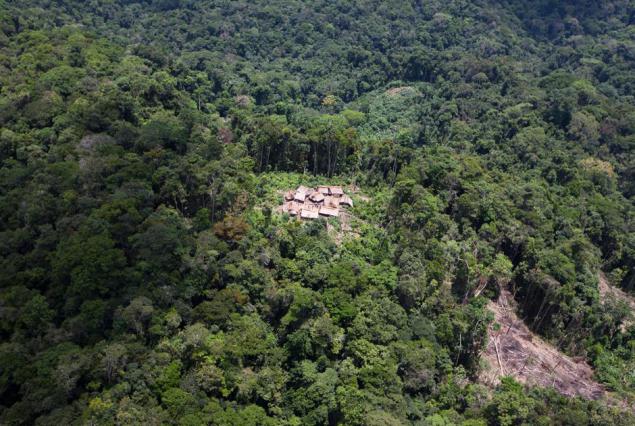
Woman Yanomami village Irotateri.
Photo: Leo Ramirez / AFP
Venezuelan authorities undertaken an investigation found no involvement in the attack on the village of illegal miners from Brazil. What really happened, and remains unknown. Yanomami have earned a reputation as fierce warriors, clans which are constantly fighting each other for the possession of women. Winners usually kill all the other children. Another unique tradition Yanomami is eating ash and milled bones of the dead members of the tribe, whose corpses are burned.

Yanomami Indian hunting.
Photo: Leo Ramirez / AFP
Yanomami not only deftly handle a bow and arrows, which are used as hunting and military weapons. They are also known for using a brass tubes, which are lubricated darts potent curare.

The village of Yanomami Indians in the Venezuelan state of Amazonas.
Photo: Leo Ramirez / AFP
Yanomami are one of the prototypes of an Indian tribe in the cult horror movie "Cannibal Holocaust" by Italian director Ruggero Deodato.
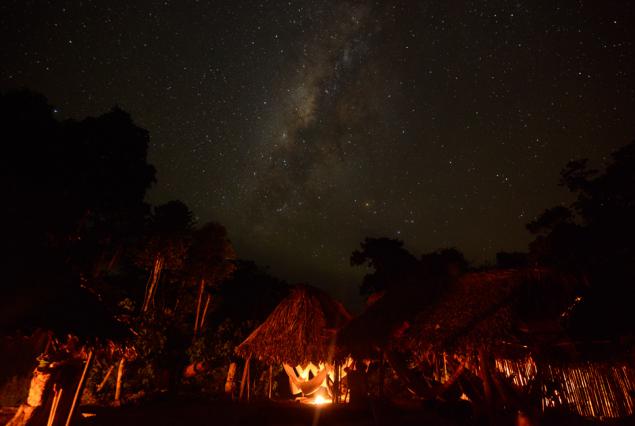
Children from a tribe Yawalapití Language play on the river Xingu, Brazil.
Photo: Ueslei Marcelino / Reuters
Yawalapití Language - small Arawak tribe (about 150 people) in the Xingu National Park, in the Brazilian state of Mato Grosso. This protected area inhabited by dozens of tribes belonging to the five language groups.
Indians Yawalapití Language participate in a wrestling tournament in the national park "Xingu".
Photo: Ueslei Marcelino / Reuters
Despite the linguistic differences, the headwaters of the Xingu Indians have similar cultural characteristics. For example, all the families gather annually on the feast of remembrance Kuarup.
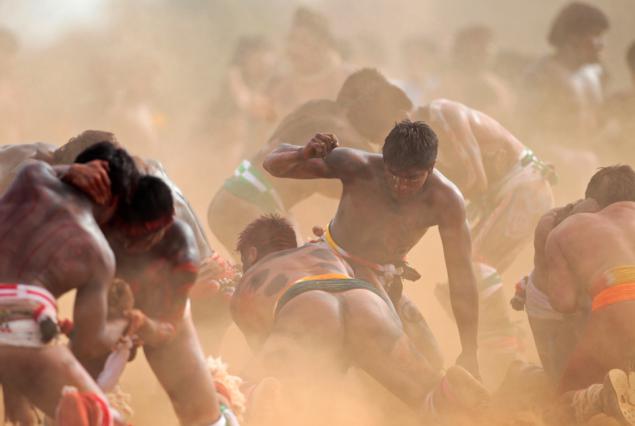
Yawalapití Language Native preparing to Kuarupu.
Photo: Ueslei Marcelino / Reuters
Kuarup dedicated to the life, death and rebirth. During the festival takes place representation of all the girls who have reached puberty during the past year. They paint their bodies, put on the best jewelry and organize dance performances to attract the best partners.

Indian Yawalapití Language Uruana plays the flute, performing a ritual of welcome good spirits. Upper Xingu.
Photo: Gregg Newton / Reuters
In the mid-1920s in the Xingu basin lost expedition of the British traveler Percy Fawcett, went in search of the lost city. Her fate remained unknown. According to one version, the expedition members murdered Indians, on the other - Fawcett disappeared from civilization to create a theosophical community.

Native demonstrates the use of a brass tube in the former Museum of the indigenous peoples of Brazil.
Photo: Christophe Simon / AFP
The museum, located near the stadium "Marakana" in Rio de Janeiro, decided to demolish to build a parking lot for the upcoming World Cup. The Indians protested against this decision since 2006, but so far to no avail.
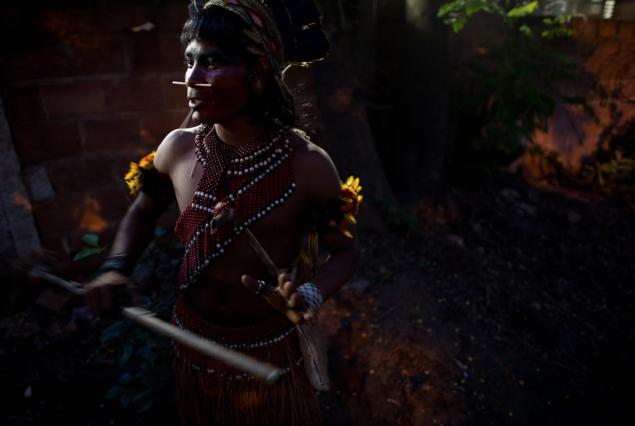
Descendants of the Tupi Indians in the demonstrations against the financing of the Brazilian Development Bank for the development of hydropower projects in Amazonia.
Photo: Antonio Scorza / AFP
Tupi was the most numerous Indian peoples of Brazil at the time of opening the country by Europeans. They all settled the Atlantic coast. To date, the Tupi completely assimilated and lost their language. Kindred Guaraní people are still many, and it is a significant part of the population of Paraguay.

Indians Mundurucu at a meeting with the leadership of Brazil in the palace of Planalto - the official residence of the head of state.
Photo: Ueslei Marcelino / Reuters
Mundurucu live in the central part of the Amazon jungle. This is a large tribe, still numbering more than 10 thousand people. Mundurucu in the XIX century and became allies of the Portuguese attack neighboring tribes, using weapons obtained from the whites. Prior to the beginning of the XX century warriors of the tribe practiced headhunting enemies skulls which were then used in magic rituals.
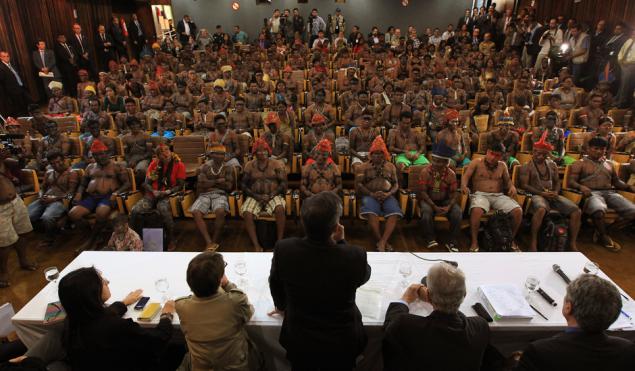
Mundurucu Indians are protesting against the construction of hydroelectric Belo Monte in Brazil.
Photo: Lunae Parracho / Reuters
In early June 2013 one hundred and fifty Mundurucu, including soldiers, women and children, were taken to the capital city of the Brazilian Air Force planes so that they can negotiate with the government. Prior to that, the Indians tried to block the construction of hydroelectric Belo Monte.

Warriors Mundurucu monitor the work of employees of the Office of Indian Affairs (FUNAI) in Brasilia.
Photo: Lunae Parracho / Reuters
During his stay in Brasilia Mundurucu first tried to storm the parliament, and then three days occupied the headquarters of the Department of Indian Affairs (FUNAI).
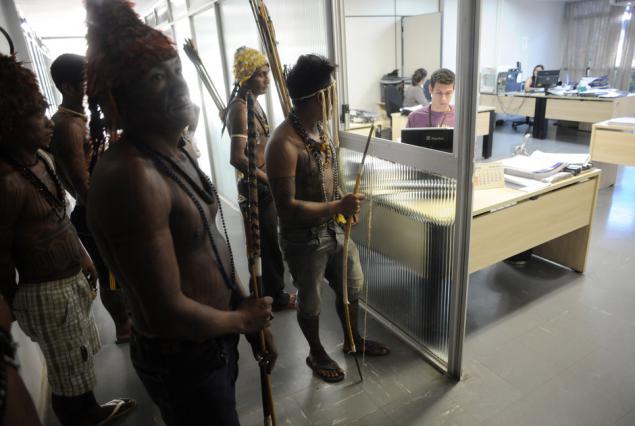
Mundurucu Brazilian Indians protest against government hydroelectric projects that threaten their environment.
Photo: Lunae Parracho / Reuters
In addition to protests against the construction of hydroelectric Belo Monte on the Xingu river Indians dissatisfied and other projects. Significant portions of the jungle will be flooded during the construction of dams on the rivers Teles Pires and Tapajós. In addition, Mundurucu condemn the government's decision to terminate the booking of agricultural land for their needs.

Mundurucu at the headquarters of the Office of Indian Affairs in Brasilia.
Photo: Ueslei Marcelino / Reuters
After a meeting with the leadership of FUNAI Mundurucu agreed to return home and 13 June, I went back to the military plane. The Indians said that the negotiations are far from complete, and pledged to continue to fight for their rights.
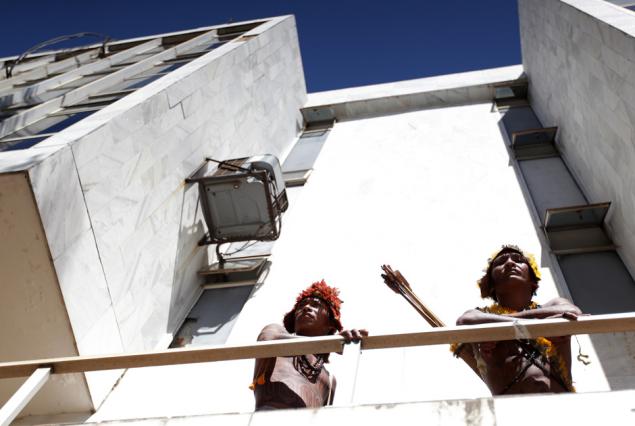
Indian woman with a child tries to resist the police during protests on the outskirts of Manaus - the capital of the Brazilian Amazon.
Photo: Luiz Vasconcelos / Reuters
Landless Movement unites Indians and Creoles, who as a result of the capture of their territories planters were left without means of subsistence. Go into the jungle, inhabited by hostile tribes, they, too, can not. From time to time they make squatting land, where they battle with the police chases.

Indian metro Rio de Janeiro.
Photo: Ricardo Moraes / Reuters
Representatives of the indigenous population of Brazil take every opportunity to draw international attention to their problems. For example, many Indians arrived in Rio de Janeiro in the summer of 2012, when the city hosts UN conference on sustainable development.

Chief Raoni Kayapo tribe has become a cultural icon and a living symbol of the struggle to save the Amazon forest.
Photo: Ueslei Marcelino / Reuters
Raoni clan metuktire about 80 years. In 1950 he first encountered white people in the face of famous anthropologists and Indian defenders Villas-Boas brothers. Thanks to their communication skills and familiarity with the "civilized" way of life, he became the leader of the local indigenous communities. With the singer Sting in the late 1980s, it managed to attract the world's attention to the problems of the Indians.

Injun in the classroom at the university for the indigenous population. Bolivar State, Venezuela.
Photo: Jorge Silva / Reuters
In Venezuela, there are about half a million Indians, who make up nearly three percent of the population. Despite legislative measures to adapt them to the modern way of life, their traditional habitat is under strain due to the exploitation of mineral deposits and deforestation.

Kayapo Indian bathes in the river Teles Pires, Brazil.
Photo: Ueslei Marcelino / Reuters
Representatives of various Indian tribes gather for an annual cultural festival, which is held in the National Park Chapada dos Veadeyrush, State of Goias. Events held in 1990. Festival Centre is a multicultural village in which representatives of different tribes acquainted with the customs of each other, to feel like a single entity.

Native American tribe Kywe guards seized a ranch in the municipality of Paranhos, Mato Grosso do Sul, Brazil.
Photo: Lunae Parracho / Reuters
Kywe, who live on the border of Brazil and Paraguay, have come under heavy pressure since the 1960s, when their lands have attracted the attention of planters. The Indians protested against the court decision ordering them to leave the territory, which they consider to be their sacred lands. Since their complaints have not been taken into account Kywe moved to self- capture of land taken away from them.
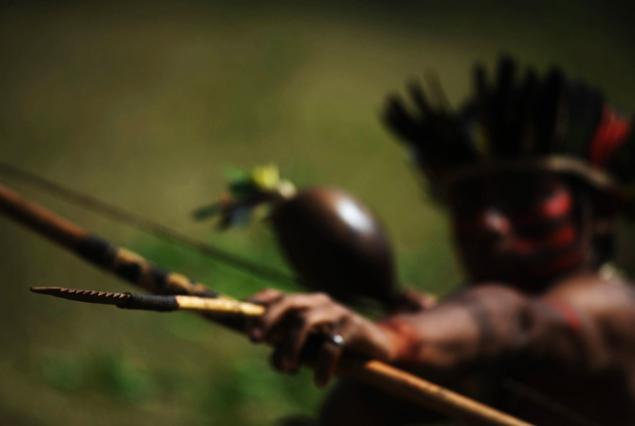
Source:
Native American tribe Arar watching competitions in archery at the festival of indigenous peoples of Brazil in the city of Altamira, state of Pará. August 15, 2005
Photo: Paulo Whitaker / Reuters
Arara live in the east in the Brazilian Amazon state of Para, between the Xingu and iriri river. They came into contact with white people in the middle of the XIX century, and now the number of the tribe does not exceed 500 people.
25 pictures via lentaru

The boy from the tribe Arar fishing in the river Xingu. Altamira, State of Para, Brazil. April 28, 2010
Photo: Ricardo Moraes / Reuters
In the municipality of Altamira, home to Arar, under construction hydroelectric Belo Monte, which will be the third largest in the world. The dam on the river Xingu would flood large areas of jungle, which causes the active protests by the Indians, who will lose their traditional habitat.

Kayapo Indian and macaw in the village Kikretum, State of Pará, Brazil.
Photo: Ricardo Moraes / Reuters
Kayapo tribe lives in the Xingu river basin in the states of Para and Mato Grosso and has nearly eight and a half thousand people. Kayapo leaders are activists of international environmental actions for the protection of the Amazon rain forest. In particular, they collaborated with popular singer Sting, in addition to well-known variety of achievements and environmental initiatives.

Kayapo boy in traditional livery. San Feliz, State of Pará, Brazil.
Photo: Ricardo Moraes / Reuters
Although the Kayapo had long been in contact with white people, but some clans living in a remote jungle, escape the influence of civilization. For example, in 2007, it was opened metyuktire tribe, whose members go completely naked. Men clothes only for the protection of the penis, while women shave their heads.

The village of Yanomami Indians in the Venezuelan state of Amazonas.
Photo: Carlos Garcia Rawlins / Reuters
Since 1960, when the Yanomami came into contact with Western civilization, do not stop their conflicts with garimpeyru gold diggers, who is at your own risk involved in the extraction of precious metals in the remote areas of the Amazon jungle. The summer of 2012 the Indians claimed that they were attacked by the Brazilian garimpeyru shelled their village by helicopter and killed 80 members of the tribe.

Woman Yanomami village Irotateri.
Photo: Leo Ramirez / AFP
Venezuelan authorities undertaken an investigation found no involvement in the attack on the village of illegal miners from Brazil. What really happened, and remains unknown. Yanomami have earned a reputation as fierce warriors, clans which are constantly fighting each other for the possession of women. Winners usually kill all the other children. Another unique tradition Yanomami is eating ash and milled bones of the dead members of the tribe, whose corpses are burned.

Yanomami Indian hunting.
Photo: Leo Ramirez / AFP
Yanomami not only deftly handle a bow and arrows, which are used as hunting and military weapons. They are also known for using a brass tubes, which are lubricated darts potent curare.

The village of Yanomami Indians in the Venezuelan state of Amazonas.
Photo: Leo Ramirez / AFP
Yanomami are one of the prototypes of an Indian tribe in the cult horror movie "Cannibal Holocaust" by Italian director Ruggero Deodato.

Children from a tribe Yawalapití Language play on the river Xingu, Brazil.
Photo: Ueslei Marcelino / Reuters
Yawalapití Language - small Arawak tribe (about 150 people) in the Xingu National Park, in the Brazilian state of Mato Grosso. This protected area inhabited by dozens of tribes belonging to the five language groups.
Indians Yawalapití Language participate in a wrestling tournament in the national park "Xingu".
Photo: Ueslei Marcelino / Reuters
Despite the linguistic differences, the headwaters of the Xingu Indians have similar cultural characteristics. For example, all the families gather annually on the feast of remembrance Kuarup.

Yawalapití Language Native preparing to Kuarupu.
Photo: Ueslei Marcelino / Reuters
Kuarup dedicated to the life, death and rebirth. During the festival takes place representation of all the girls who have reached puberty during the past year. They paint their bodies, put on the best jewelry and organize dance performances to attract the best partners.

Indian Yawalapití Language Uruana plays the flute, performing a ritual of welcome good spirits. Upper Xingu.
Photo: Gregg Newton / Reuters
In the mid-1920s in the Xingu basin lost expedition of the British traveler Percy Fawcett, went in search of the lost city. Her fate remained unknown. According to one version, the expedition members murdered Indians, on the other - Fawcett disappeared from civilization to create a theosophical community.

Native demonstrates the use of a brass tube in the former Museum of the indigenous peoples of Brazil.
Photo: Christophe Simon / AFP
The museum, located near the stadium "Marakana" in Rio de Janeiro, decided to demolish to build a parking lot for the upcoming World Cup. The Indians protested against this decision since 2006, but so far to no avail.

Descendants of the Tupi Indians in the demonstrations against the financing of the Brazilian Development Bank for the development of hydropower projects in Amazonia.
Photo: Antonio Scorza / AFP
Tupi was the most numerous Indian peoples of Brazil at the time of opening the country by Europeans. They all settled the Atlantic coast. To date, the Tupi completely assimilated and lost their language. Kindred Guaraní people are still many, and it is a significant part of the population of Paraguay.

Indians Mundurucu at a meeting with the leadership of Brazil in the palace of Planalto - the official residence of the head of state.
Photo: Ueslei Marcelino / Reuters
Mundurucu live in the central part of the Amazon jungle. This is a large tribe, still numbering more than 10 thousand people. Mundurucu in the XIX century and became allies of the Portuguese attack neighboring tribes, using weapons obtained from the whites. Prior to the beginning of the XX century warriors of the tribe practiced headhunting enemies skulls which were then used in magic rituals.

Mundurucu Indians are protesting against the construction of hydroelectric Belo Monte in Brazil.
Photo: Lunae Parracho / Reuters
In early June 2013 one hundred and fifty Mundurucu, including soldiers, women and children, were taken to the capital city of the Brazilian Air Force planes so that they can negotiate with the government. Prior to that, the Indians tried to block the construction of hydroelectric Belo Monte.

Warriors Mundurucu monitor the work of employees of the Office of Indian Affairs (FUNAI) in Brasilia.
Photo: Lunae Parracho / Reuters
During his stay in Brasilia Mundurucu first tried to storm the parliament, and then three days occupied the headquarters of the Department of Indian Affairs (FUNAI).

Mundurucu Brazilian Indians protest against government hydroelectric projects that threaten their environment.
Photo: Lunae Parracho / Reuters
In addition to protests against the construction of hydroelectric Belo Monte on the Xingu river Indians dissatisfied and other projects. Significant portions of the jungle will be flooded during the construction of dams on the rivers Teles Pires and Tapajós. In addition, Mundurucu condemn the government's decision to terminate the booking of agricultural land for their needs.

Mundurucu at the headquarters of the Office of Indian Affairs in Brasilia.
Photo: Ueslei Marcelino / Reuters
After a meeting with the leadership of FUNAI Mundurucu agreed to return home and 13 June, I went back to the military plane. The Indians said that the negotiations are far from complete, and pledged to continue to fight for their rights.

Indian woman with a child tries to resist the police during protests on the outskirts of Manaus - the capital of the Brazilian Amazon.
Photo: Luiz Vasconcelos / Reuters
Landless Movement unites Indians and Creoles, who as a result of the capture of their territories planters were left without means of subsistence. Go into the jungle, inhabited by hostile tribes, they, too, can not. From time to time they make squatting land, where they battle with the police chases.

Indian metro Rio de Janeiro.
Photo: Ricardo Moraes / Reuters
Representatives of the indigenous population of Brazil take every opportunity to draw international attention to their problems. For example, many Indians arrived in Rio de Janeiro in the summer of 2012, when the city hosts UN conference on sustainable development.

Chief Raoni Kayapo tribe has become a cultural icon and a living symbol of the struggle to save the Amazon forest.
Photo: Ueslei Marcelino / Reuters
Raoni clan metuktire about 80 years. In 1950 he first encountered white people in the face of famous anthropologists and Indian defenders Villas-Boas brothers. Thanks to their communication skills and familiarity with the "civilized" way of life, he became the leader of the local indigenous communities. With the singer Sting in the late 1980s, it managed to attract the world's attention to the problems of the Indians.

Injun in the classroom at the university for the indigenous population. Bolivar State, Venezuela.
Photo: Jorge Silva / Reuters
In Venezuela, there are about half a million Indians, who make up nearly three percent of the population. Despite legislative measures to adapt them to the modern way of life, their traditional habitat is under strain due to the exploitation of mineral deposits and deforestation.

Kayapo Indian bathes in the river Teles Pires, Brazil.
Photo: Ueslei Marcelino / Reuters
Representatives of various Indian tribes gather for an annual cultural festival, which is held in the National Park Chapada dos Veadeyrush, State of Goias. Events held in 1990. Festival Centre is a multicultural village in which representatives of different tribes acquainted with the customs of each other, to feel like a single entity.

Native American tribe Kywe guards seized a ranch in the municipality of Paranhos, Mato Grosso do Sul, Brazil.
Photo: Lunae Parracho / Reuters
Kywe, who live on the border of Brazil and Paraguay, have come under heavy pressure since the 1960s, when their lands have attracted the attention of planters. The Indians protested against the court decision ordering them to leave the territory, which they consider to be their sacred lands. Since their complaints have not been taken into account Kywe moved to self- capture of land taken away from them.

Source:










